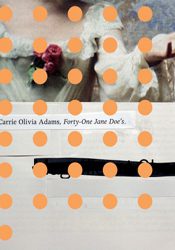
Forty-One Jane Doe’s, Carrie Olivia Adams’ recently published second collection, is magic. Which is to say I am entranced by the poems in this carefully-crafted book. I am immediately put under the spell of Adams’ words, and of the worlds that her poems inhabit.
I don’t mean to suggest that Adams employs trickery. Quite the contrary—her writing is specific (without being limiting) and straightforward (without offering a conclusive narrative). In the opening stanza of the section “Winter Came” she writes:
This was the year I deserved the winter,
and when it came there was nothing
I could say—
I could not send it back.
It had come for me.
There is nothing hidden here; Adams is not playing games with her reader. She shoots straight from the hip, and her aim is true.
It is difficult not to imagine the “I” in these poems as Adams herself, although one never knows. Perhaps, like the many versions of Jane Doe that we meet in the title section of the book, the “I” is many versions of Adams. Perhaps the “I” is entirely other from the writer (though I am more doubtful than usual of this).
The “I” in Forty-One Jane Doe’s takes on identities. She is Pandora, opening the box: “It was me. There was no lock or key. I just asked, ‘Shall I?’/And the stars fell out.” In the first section of the collection, aptly titled “A Mystery Story,” she is a detective, investigating the weather. She is alternately knowing and wondering, known and unknown.
What is clear throughout is the presence of a narrator, serving not as lecturer or advisor to the reader but as guide and interrogator. The “I” addresses the reader directly in the section “Technologies”: “My body./Reader,/he strokes it in letters” and “Reader, you and I have been lashed/by the weather. We’ve been let down.” A few pages later, the “I” questions the reader, asking “Do you know mathematical beauty, reader?” and then acknowledges itself:
It is an act of extreme egotism to believe
that my being [here]
changes the city.
Disrupts it so.
A windbreak. A shadow caster.
My breath catches. Extends.
Self or selfless,
I am in the way.
Whoever she is, the “I” in Adams’ poetry is aware, of herself and of everything she encounters. She is as inquisitive as she is introspective—Forty-One Jane Doe’s is a book of investigation, of questioning. “Why must the body insist?” asks the narrator in a later section of the book. But as we’ve already been told, “The detective/she leaves it to you.”
There are clues that serve both to clarify and to confuse. “The first clue is snowflakes,” but also, “The first clue is wide-eyed.” There are hand-delivered clues and clues made of “paper/wrapped.” There are hints and evidence. And, “Some days there are no clues/other than the patterns of migrating birds.”
There are windows. Pandora gives her box an intentional window “[t]o become perceptible; to be expressed; to permit passage; to make manifest. Maybe for all these reasons. It caught a cluster, a bee and a thistle; the spindle of a watch balance. The sun on the tip of a matchstick.” Later on, there is an accidental window, an unintentional aperture as “the ceiling collapsed,/the roof opened to reveal the sky/yawning back at me—.”
And, of course, there are the Janes. The title section begins, “There are Janes for everyday./And there are sometime Janes.” There are recognizable, apparent Janes and there are hidden Janes. The Janes are distinct and unique, but crowd them “in a graffitied bathroom stall” and “they would all be dialing the same number.”
Adams shifts back and forth between the plural and singular in this section. The many Janes sometimes coalesce into one Jane:
Mornings, Jane tries to look so tall,
no matter what she’s carrying.
She strides down the wooden train platform, one hand
holding her skirt against the breeze, the other clutching.
And then are split apart into multiples again:
One day there were high rise office buildings
and tenements and grids
and alleyways sunk under with rain water.
And then the Janes came with them.
Above all else, the Janes are aware: “One Jane Doe remember burying / Jane Doe in the sand. There is a moment, she says,/when you know what you are doing / is wrong, but you do it anyway.” This is a poetry concerned with the specificities of the universe, of nature, of science and of the body, of love and of pain. The Janes are aware, the “I” is aware, and Adams is aware.
Forty-One Jane Doe’s closes, fittingly, with a question:
If you know the end,
if the day has already come
and another begun for you
can you tell me of it,
so I may know
what to look for?
Like I said, this poetry is magic. Ultimately, Adams challenges her readers to observe intensely the world around us, to decide for ourselves which particulars are clues to be deciphered and which questions are asking for our answers.
(Note: Three short films, created in tandem with the writing, accompany Forty-One Jane Doe’s. The images presented in these films serve to reinforce and inform the poems. I’d recommend reading the book in its entirety prior to viewing the films.)




